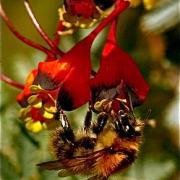
The St Mark's Park runway strip first reported in Issue 206 is, it turns out, a flower meadow in progress.
Annual native plants are being encouraged which naturally flourish, die back and replace each other throughout mid-summer and early autumn. A colourful display is expected within weeks.
Perennial species have been sown here and in Pilrig Park, including field cowslip, ox-eye daisy, red campion, scabious, tufted vetch and yarrow. They will be mown this year to a height of 10cms, but should really come into their own in 2013.
Next summer, scientists will arrive to monitor the type and number of insects visiting the meadows.They aim to answer three questions:
- Where exactly is the pollinator biodiversity in the UK – urban habitats, farmland or nature reserves?
- Where are the hot-spots of pollinator biodiversity in cities?
- What can be done to improve their diversity and abundance in cities?
To answer the first two questions, they will look at whole communities of bees, flies, butterflies and beetles visiting flowers, and construct food webs which describe the patterns of flower–insect interactions.
To answer the third question, they will add flower mixtures high in nectar and pollen to selected city habitats and test whether this increases pollinator species' richness and abundance.
St Mark's and Pilrig Parks are two of 15 such wildflower meadows which have been sown across the capital as part of the Urban Pollinator Project: a collaboration between the Council and scientists at Edinburgh University. Similar projects are being run in Bristol, Leeds and Reading.
The project is funded jointly by a grant from BBSRC, DEFRA, NERC, the Scottish Government and the Wellcome Trust, under the Insect Pollinators Initiative.
[img_assist|nid=3072|title=|desc=|link=node|align=none|width=640|height=427]
Photo courtesy of [www.crinklecrankle.com/].